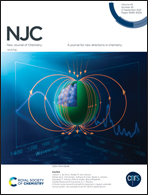A smart sensing Zn(ii) coordination polymer based on a new viologen ligand exhibiting photochromic and thermochromic and multiple solid detection properties†
Abstract
Through the self-assembly of 1,1′-bis(3-cyanobenzyl)-[4,4′-bipyridine] dichloride ligand, m-H2BDC and Zn(NO3)2·6H2O, a novel one-dimensional chain structure multifunctional coordination polymer was successfully synthesized. Due to electron transfer during irradiation and heating to generate viologen free radicals, this compound displays both photochromism and thermochromism. Besides, it can respond to blue light to a certain extent. Because of the electron deficiency of viologen, the coordination polymer can detect amines with different molecular sizes and types, which can cause different color changes. In this process, electrons are transferred from organic amines to N+ sites of the viologen ligand. Therefore, the compound can selectively detect amines. The compound can not only cause visible color changes to amines, but also can selectively detect benzenes by fluorescence. At the same time, the photo-controlled fluorescence and thermal-controlled properties of the compound were studied, simultaneously.



 Please wait while we load your content...
Please wait while we load your content...